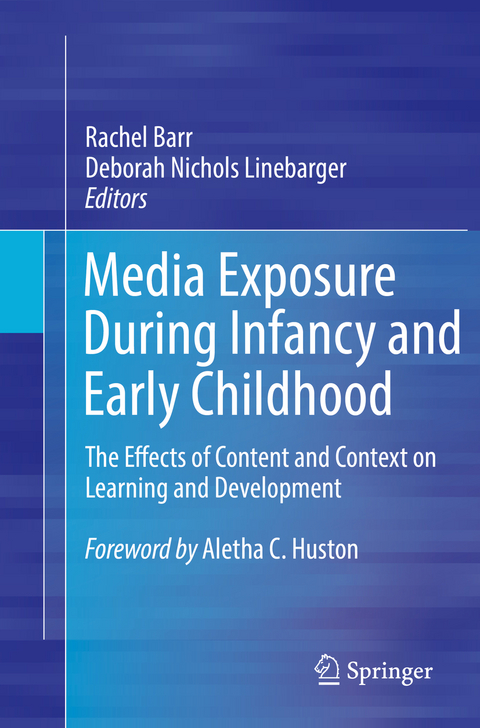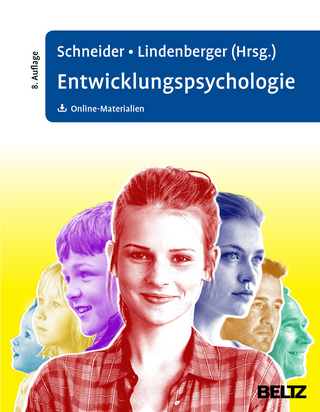
Media Exposure During Infancy and Early Childhood
Springer International Publishing (Verlag)
978-3-319-99376-8 (ISBN)
This book discusses the burgeoning world of young children's exposure to educational media and its myriad implications for research, theory, practice, and policy. Experts across academic disciplines and the media fill knowledge gaps and address concerns regarding apps, eBooks, and other screen-based technologies-which are being used by younger and younger children-and content delivery and design. Current research shows the developmental nuances of the child as learner in home, school, and mobile contexts, and the changes as parenting and pedagogy accommodate the complexities of the new interactive world. The book also covers methods for evaluating the quality of new media and prosocial digital innovations such as video support for separated families and specialized apps for at-risk toddlers.
Highlights of the coverage:
- The role of content and context on learning and development from mobile media.
- Learning from TV and touchscreens during early childhood
- Educational preschool programming.
- How producers craft engaging characters to drive content delivery.
- The parental media mediation context of young children's media use.
- Supporting children to find their own agency in learning.
Media Exposure During Infancy and Early Childhood is an essential resource for researchers, clinicians and related professionals, and graduate students in diverse fields including infancy and early childhood development, child and school psychology, social work, pediatrics, and educational psychology.
Rachel Barr, Ph.D., is Associate Professor of Psychology at Georgetown University and Director of the Georgetown Early Learning Project. Dr. Barr received her Ph.D. from the University of Otago, New Zealand. She is primarily interested in how children bridge the gap between what they learn from media and how they apply that information in the real world. She has written frequently about the Transfer deficit which is the consistent finding that infants and toddlers learn less from television and touchscreens than from face-to-face interactions due to memory constraints and also how the transfer deficit can be ameliorated by including repetition, additional language cues and appropriate use of television features to enhance learning. She has also examined how parents can facilitate learning from both touchscreens and television. Finally, she has provided developmental expertise while working with media developers and she has collaborated on a project that has used media content as part of an early intervention parenting program for incarcerated teen fathers. Deborah Nichols Linebarger, Ph.D., is Associate Professor of Human Development and Director of the Children's Media Lab at Purdue University. Dr. Linebarger received her Ph.D. from the University of Texas, Austin. She is primarily interested in the interface between children's cognitive development (i.e., learning, language and early literacy skills, executive function) and educational media and how and whether these relations vary by important demographic and social indicators including poverty status, culturally- and linguistically-diverse populations, age, and location of residence (e.g., rural or urban). To examine this interface, she conducts descriptive work to detail media access and use patterns and relations among these patterns and child development; micro-level experimental work to detect the features used in media that direct attention and contribute to content comprehension; and macro-level intervention work that combines the knowledge gained through both descriptive and basic research and applies it in various real-world contexts. In the latter capacity, she has extensive experience evaluating the efficacy of various media products and media interventions (i.e., 22 different products and interventions evaluated across 52 different studies) using theoretically- and empirically-rigorous research methods and evaluation techniques. Recent projects and consultancies include Sesame Workshop, PBS Kids/CPB, Between the Lions, WGBH public TV, Sprout, LeapFrog, Disney, Nickleodeon, the World Bank, and members of Congress.
Foreword; Aletha C. Huston.- Preface; Rachel Barr and Deborah Nichols Linebarger.- Chapter 1. The "New" Technology Environment: The Role of Content and Context on Learning and Development from Mobile Media; Alexis R. Lauricella, Courtney K. Blackwell, and Ellen Wartella.- Chapter 2. Who's By Their Side? Questions of Context Deepen the Research on Children and Media: Commentary on Chapter 1; Lisa Guernsey.- Chapter 3. The Dimensional Divide: Learning from TV and Touchscreens During Early Childhood; Daniel Hipp, Peter Gerhardstein, Laura Zimmermann, Alecia Moser, Gemma Taylor, and Rachel Barr.- Chapter 4. Bridging the Dimensional Divide in the Real World: Commentary on Chapter 3; Kara Garrity Liebeskind and Alyson Bryant.- Chapter 5. The Role of Online Processing in Young Children's Ability to Learn from Interactive and Noninteractive Digital Media; Heather Kirkorian, Tiffany Pempek, and Koeun Choi.- Chapter 6. What's in a Look? How YoungChildren Learn from Screen Media and Implications for Early Educators: Commentary on Chapter 5; Michael Robb.- Chapter 7. What Makes Preschool Educational Television Educational? A Content Analysis of Literacy, Language-Promoting, and Prosocial Preschool Programming; Deborah Nichols Linebarger, Elizabeth Brey, Susan Fenstermacher, and Rachel Barr.- Chapter 8. Is Preschool Programming Educational?: Commentary on Chapter 7; Angela C. Santomero.- Chapter 9. Media Characters, Parasocial Relationships, and the Social Aspects of Children's Learning Across Media Platforms; Melissa N. Richards and Sandra L. Calvert.- Chapter 10. Character Development in Practice: How Producers Craft Engaging Characters to Drive Content Delivery: Commentary on Chapter 9; Linda Simensky.- Chapter 11. Screen Media and Parent-Child Interactions; Daniel R. Anderson and Katherine G. Hanson.- Chapter 12. Context Matters - How Co-Using Screen Media Impacts Young Children: Commentary on Chapter 11; Claire Lerner.- Chapter 13. The Parental Media Mediation Context of Young Children's Media Use; Jessica Taylor Piotrowski.- Chapter 14. Parental Mediation in an Evolving Media Landscape - Commonalities, Contrasts, and Implications for Design: Commentary on Chapter 13; Shalom M. Fisch.- Chapter 15. Building Family Relationships from a Distance: Supporting Connections with Babies and Toddlers Using Video and Video Chat; Elisabeth McClure and Rachel Barr.- Chapter 16. Smarter, Stronger, Kinder - Developing Effective Media-Based Tools for At-Risk Populations: Commentary on Chapter 15; Rosemarie T. Truglio and Jennifer Kotler.- Chapter 17. Putting the Education Back in Educational Apps: How Content and Context Interact to Promote Learning; Jennifer M. Zosh, Sarah Roseberry Lytle, Roberta Michnick Golinkoff, and Kathy Hirsh-Pasek.- Chapter 18. Supporting Children to Find Their Own Agency in Learning: Commentary on Chapter 17; Jeremy Boyle and Melissa Butler.- Chapter 19. Conclusions: Making Screens Make Sense for Young Children; Deborah Nichols Linebarger and Rachel Barr.
"This book examines how children are affected by media exposure of all types and the implications for research and early childhood development strategies. ... This book would be of most interest to clinicians, researchers, and professionals in early childhood development, mental health, and social sciences, as well as academicians in the field of educational psychology and graduate psychology courses." (Michael S. Goldsby, Doody's Book Reviews, September, 2017)
| Erscheinungsdatum | 19.08.2018 |
|---|---|
| Zusatzinfo | XXV, 303 p. 27 illus., 24 illus. in color. |
| Verlagsort | Cham |
| Sprache | englisch |
| Maße | 155 x 235 mm |
| Gewicht | 473 g |
| Themenwelt | Geisteswissenschaften ► Psychologie ► Entwicklungspsychologie |
| Medizin / Pharmazie ► Medizinische Fachgebiete ► Pädiatrie | |
| Sozialwissenschaften ► Pädagogik ► Sozialpädagogik | |
| Schlagworte | At-risk populations and early child development • Cultural, linguistic, and socio-economic diversity • Domestic and international media development • Early child development and media • Implications of media exposure on young children • Infant learning and cognition • Infants and media exposure • Media and early child development • Media content and policy • Mobile devices and early child development • Parasocial interactions in infants • Parent-child interactions • Preschoolers and media exposure • Resilience in infants • Selective attention in infants • Skype and early child development • Tablets and early child development • Television and early child development • Touchscreens and early child development • Transfer deficit in infants |
| ISBN-10 | 3-319-99376-3 / 3319993763 |
| ISBN-13 | 978-3-319-99376-8 / 9783319993768 |
| Zustand | Neuware |
| Haben Sie eine Frage zum Produkt? |
aus dem Bereich


